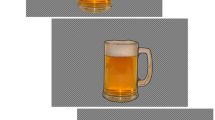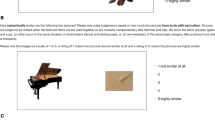Abstract
In this study, we provide normative data for objects in a set of 80 digital color pictures (e.g., nature scenes, human activities, cartoon characters, magazine covers). In Experiment 1, four objects in each picture were rated by 48 observers on a 6-point Likert scale for their relevance to the overall meaning of the scene. In Experiment 2, Salience Toolbox software (Walther & Koch, 2006) provided additional information about whether the four relevance-rated objects were located in areas that were high or low in visual salience. Brief descriptions of the four objects, their locations in the picture, their categorizations as high or low in salience, the means and standard deviations of their relevance ratings, and statistical analyses specifying which pairs of objects in a picture differed significantly on their relevance to the meaning of the scene are given in the Appendix. An example is provided of how the pictures could be used to create stimuli for a change blindness task in which detection of item onset versus offset is contrasted for low-relevance and high-relevance features. The 80 pictures are accessible as jpg files from the first author’s Web site at http://marcellm.people.cofc.edu/research.htm.
Similar content being viewed by others
References
DiVita, J., Obermayer, R., Nugent, W., & Linville, J. M. (2004). Verification of the change blindness phenomenon while managing critical events on a combat information display. Human Factors, 46, 205–218.
Donk, M., & van Zoest, W. (2008). Effects of salience are short-lived. Psychological Science, 19, 733–739.
Elazary, L., & Itti, L. (2008). Interesting objects are visually salient. Journal of Vision, 8(3, Art. 3), 1–15.
Hollingworth, A., & Henderson, J. M. (2000). Semantic informativeness mediates the detection of changes in natural scenes. Visual Cognition, 7, 213–235.
Itti, L., Koch, C., & Niebur, E. (1998). A model of saliency-based visual attention for rapid scene analysis. IEEE Transactions on Pattern Analysis & Machine Intelligence, 20, 1254–1259.
Koch, C., & Ullman, S. (1985). Shifts in selective visual attention: Towards the underlying neural circuitry. Human Neurobiology, 4, 219–227.
Levin, D. T., Momen, N., Drivdahl, S. B., & Simons, D. J. (2000). Change blindness blindness: The metacognitive error of overestimating change-detection ability. Visual Cognition, 7, 397–412.
Levin, D. T., & Simons, D. J. (1997). Failure to detect changes to attended objects in motion pictures. Psychonomic Bulletin & Review, 4, 501–506.
O’Regan, J. K., Deubel, H., Clark, J. J., & Rensink, R. A. (2000). Picture changes during blinks: Looking without seeing and seeing without looking. Visual Cognition, 7, 191–211.
O’Regan, J. K., Rensink, R. A., & Clark, J. J. (1999). Change blindness as a result of “mudsplashes.” Nature, 398, 34.
Pearson, P. M., & Schaefer, E. G. (2005). Toupee or not toupee? The role of instructional set, centrality, and relevance in change blindness. Visual Cognition, 12, 1528–1543.
Pringle, H. L., Irwin, D. E., Kramer, A. F., & Atchley, P. (2001). The role of attentional breadth in perceptual change detection. Psychonomic Bulletin & Review, 8, 89–95.
Rayner, K., Balota, D. A., & Pollatsek, A. (1986). Against parafoveal semantic preprocessing during eye fixations in reading. Canadian Journal of Psychology, 40, 473–483.
Rensink, R. A., O’Regan, J. K., & Clark, J. J. (1997). To see or not to see: The need for attention to perceive changes in scenes. Psychological Science, 8, 368–373.
Rensink, R. A., O’Regan, J. K., & Clark, J. J. (2000). On the failure to detect changes in scenes across brief interruptions. Visual Cognition, 7, 127–145.
Shore, D. I., & Klein, R. M. (2000). The effects of scene inversion on change blindness. Journal of General Psychology, 127, 27–43.
Stirk, J. A., & Underwood, G. (2007). Low-level visual saliency does not predict change detection in natural scenes. Journal of Vision, 7(10, Art. 3), 1–10.
Wallis, G., & Bülthoff, H. (2000). What’s scene and not seen: Influences of movement and task upon what we see. Visual Cognition, 7, 175–190.
Walther, D., & Koch, C. (2006). Modeling attention to salient protoobjects. Neural Networks, 19, 1395–1407.
Werner, S., & Thies, B. (2000). Is “change blindness” attenuated by domain-specific expertise? An expert—novices comparison of change detection in football images. Visual Cognition, 7, 163–173.
Wright, M. J. (2005). Saliency predicts change detection in pictures of natural scenes. Spatial Vision, 18, 413–430.
Author information
Authors and Affiliations
Corresponding author
Additional information
The project was completed in partial fulfillment of the second author’s Bachelor’s Essay requirement in the Honors College of College of Charleston.
Note—This article was accepted by the previous editorial team, when John H. Krantz was Editor.
Rights and permissions
About this article
Cite this article
Marcell, M.M., Williams, E. Relevance ratings and salience categorizations for objects in a set of 80 pictures. Behavior Research Methods 42, 438–451 (2010). https://doi.org/10.3758/BRM.42.2.438
Received:
Accepted:
Published:
Issue Date:
DOI: https://doi.org/10.3758/BRM.42.2.438




